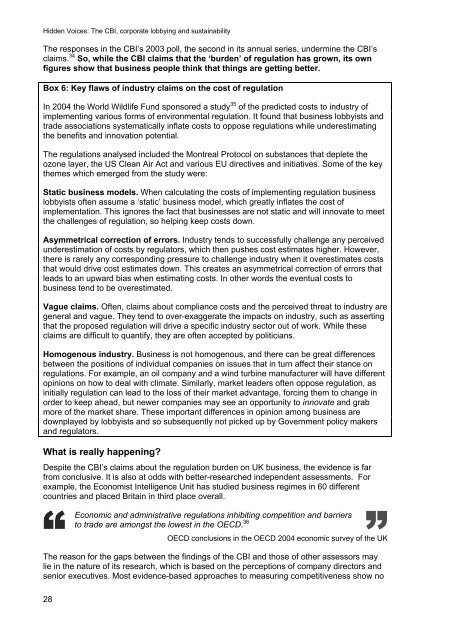hidden_voices
hidden_voices
hidden_voices
Create successful ePaper yourself
Turn your PDF publications into a flip-book with our unique Google optimized e-Paper software.
Hidden Voices: The CBI, corporate lobbying and sustainabilityThe responses in the CBI’s 2003 poll, the second in its annual series, undermine the CBI’sclaims. 34 So, while the CBI claims that the ‘burden’ of regulation has grown, its ownfigures show that business people think that things are getting better.Box 6: Key flaws of industry claims on the cost of regulationIn 2004 the World Wildlife Fund sponsored a study 35 of the predicted costs to industry ofimplementing various forms of environmental regulation. It found that business lobbyists andtrade associations systematically inflate costs to oppose regulations while underestimatingthe benefits and innovation potential.The regulations analysed included the Montreal Protocol on substances that deplete theozone layer, the US Clean Air Act and various EU directives and initiatives. Some of the keythemes which emerged from the study were:Static business models. When calculating the costs of implementing regulation businesslobbyists often assume a ‘static’ business model, which greatly inflates the cost ofimplementation. This ignores the fact that businesses are not static and will innovate to meetthe challenges of regulation, so helping keep costs down.Asymmetrical correction of errors. Industry tends to successfully challenge any perceivedunderestimation of costs by regulators, which then pushes cost estimates higher. However,there is rarely any corresponding pressure to challenge industry when it overestimates coststhat would drive cost estimates down. This creates an asymmetrical correction of errors thatleads to an upward bias when estimating costs. In other words the eventual costs tobusiness tend to be overestimated.Vague claims. Often, claims about compliance costs and the perceived threat to industry aregeneral and vague. They tend to over-exaggerate the impacts on industry, such as assertingthat the proposed regulation will drive a specific industry sector out of work. While theseclaims are difficult to quantify, they are often accepted by politicians.Homogenous industry. Business is not homogenous, and there can be great differencesbetween the positions of individual companies on issues that in turn affect their stance onregulations. For example, an oil company and a wind turbine manufacturer will have differentopinions on how to deal with climate. Similarly, market leaders often oppose regulation, asinitially regulation can lead to the loss of their market advantage, forcing them to change inorder to keep ahead, but newer companies may see an opportunity to innovate and grabmore of the market share. These important differences in opinion among business aredownplayed by lobbyists and so subsequently not picked up by Government policy makersand regulators.What is really happening?Despite the CBI’s claims about the regulation burden on UK business, the evidence is farfrom conclusive. It is also at odds with better-researched independent assessments. Forexample, the Economist Intelligence Unit has studied business regimes in 60 differentcountries and placed Britain in third place overall.Economic and administrative regulations inhibiting competition and barriersto trade are amongst the lowest in the OECD. 36OECD conclusions in the OECD 2004 economic survey of the UKThe reason for the gaps between the findings of the CBI and those of other assessors maylie in the nature of its research, which is based on the perceptions of company directors andsenior executives. Most evidence-based approaches to measuring competitiveness show no28


